Dynamic Modeling and Coupling Characteristic Analysis of Two-Axis Rate Gyro Seeker
Abstract
A dynamic model of a two-axis rate gyro-stabilized platform-based seeker with cross-coupling, mass imbalance, and disturbance torque is developed on the basis of the working principle of seeker two-loop steady tracking theory; coordinate transformations are used to analyze the effects of seeker servo control mode on missile guidance and control systems. Frequency domain is used to identify the servo motor transfer function. Furthermore, a block diagram of the two-gimbal-coupled system is developed, and the coupling characteristics of gimbal angle are analyzed with different missile body inputs. Simulation results show that the analysis conforms with the actual movement rule of seeker gimbal and optical axis, and cross-coupling exists between the two gimbals. The lag compensation network can increase the open loop gain and increase the capacity for disturbance rate rejection. Simulations validate the theory and technology support for developing the seeker servo control model in engineering.
1. Introduction
The radar seeker has many advantages, such as high-range, all-weather detection capability, compared with traditional photoelectric seeker [1]. Therefore, a radar seeker can be a more effective choice in developing military power or upgrading missile systems than traditional photoelectric seeker [2]. Radar seeker servo system is a key part of a precise, stable target tracking system. The core of the radar seeker is a precise electromechanical servo device that compensates for the missile body disturbance to the beam axis of the seeker [3, 4] and maintains the beam-pointing stability in space, thus tracking the line of sight quickly. Two major types of stable servo seeker in history [5], namely, dynamic gyro and rate gyro stabilization modes, are used to meet different needs. In [6], the dynamic modeling and simulation of the dynamic gyro-type seeker were conducted, and the influence of the missile disturbance on the servo control system of the seeker was analyzed; however, the disadvantages of the dynamic gyro seeker include low load capacity, large forward torque, and delayed response. In [7], the stability tracking principle of rate gyroscope-stabilized laser seeker was investigated; the stability of the seeker load is high, and the reaction speed is fast.
When a radar system for tracking and measuring target is accommodated on a moving carrier, a line of sight stabilization system is the basis for high-precision tracking. In order to eliminate the influence of the carrier, a stable platform is usually available to achieve the stability of the line of sight; according to different stable objects and stability requirements, there can be various ways of stability [8–10]. In order to precisely control the line of sight of the detection system and make it track the target motion accurately while isolating the missile body disturbance, some scholars adopted a variety of stable platform schemes and control methods [11–13]. Unlike the airborne or ground-based tracking radar case, the radar seeker will output line of sight (LOS) angle rate for terminal guidance of homing missile using proportional navigation [14]. In [15], a stable platform control loop of a seeker was designed and the effect of disturbance moment on LOS tracking was analyzed. The guidance accuracy of the homing missile will be affected by the LOS rate output accuracy because the output error of the LOS rate caused by servo platform disturbance torque would induce the disturbing rate rejection, thereby resulting in its parasitical loop. In [16–18], the effect of disturbing rate rejection caused by spring and damping torques on the stability of the guidance system was analyzed. Any deviation in the course of the seeker control loop will make the body attitude angle couple into the LOS rate output, because the missile will be subject to airflow, disturbance torque in the flight process, thereby affecting the stability and tracking of the radar seeker beam axis and reducing the missile guidance accuracy [19–22]. Therefore, the two-channel rate gyro servo platform-type seeker-coupled model must be studied by using the platform kinematic [23, 24] and dynamic models [25].
The current study is aimed at building a dynamic model of two-axis rate gyro radar seeker and analyze the coupling characteristics between the two channels. The rest of this paper is organized as follows: Section 2 introduces the rate gyro stabilization platform tracking principle. Section 3 builds a dynamic model of two-axis platform radar seeker, including mass imbalance, disturbance torque, and cross-coupling. Section 4 introduces a frequency domain servo motor transfer function identification method, which provides reasonable design parameters for the seeker control system. Section 5 designs the lag compensation network parameters for tracking loop and stability loop, respectively, analyzes the characteristic in frequency domain and at the same time analyzes the influence of the missile motion on the angle of the gimbal, disturbance rate rejection characteristic and coupling effect between the two gimbals by simulation. Section 6 concludes the study.
2. Rate Gyro Stabilization Platform Tracking Principle
The radar seeker servo device consists of a gyro assembly, DC torque motor, angular position sensor, radar signal processing system, and yaw and pitch gimbals [26]. Figure 1 illustrates the schematic of two-axis rate gyro stability platform. The outer gimbal is the pitch gimbal, the inner gimbal is the yaw gimbal, and they are connected by the bearing; thus, the ring gimbal can rotate around each other. The outer gimbal shaft is mounted on two brackets through the bearing gimbal, and the bracket and the base are fixed together. The torque motor is mounted on one end of the shaft to enable the rotation of the shaft. The potentiometer gauge is mounted on the other end of the shaft to measure the rotation angle of the gimbal relative to the base. The inner gimbal passes through the bearing gimbal on the outer gimbal. The torque motor is also mounted on one end of the inner gimbal shaft, and the potentiometer is mounted on the other end. The two rate gyros are mounted on the inner gimbal to measure the rotation angle rate of the inner gimbal relative to the inertial space. The measured value is equal to the true LOS angle rate and can be used to guide the missile. The radar antenna is also mounted on the inner gimbal.
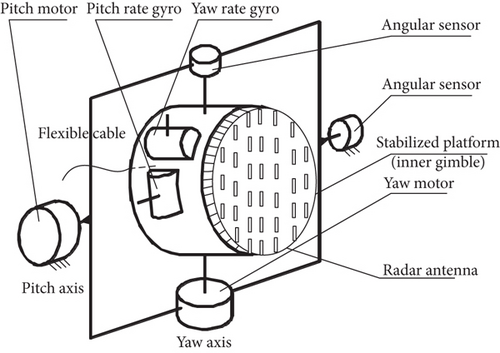
The radar antenna and inertial device (rate gyro) are mounted on the inner gimbal of the stable platform. Any movement of the platform in inertial space will be sensed by the inertial devices. The real antenna beam off-centered angle signals are sent to the corresponding electric motor to control the platform back to the initial reference orientation in the inertial space, which is a function of the seeker stability loop. The radar seeker antenna measures the angle error between the beam direction and the true LOS to track the target, thus forming negative angle feedback to achieve closed loop tracking control by angle tracking loop.
3. Dynamic Model of Two-Axis Platform Radar Seeker
3.1. Coordinate System Definition and Transformation
- (1)
Inertial coordinate system Oxiyizi: the Oxi-axis points to the earth plane flat, and the Oyi-axis points along the vertical direction. The Ozi-axis direction can be obtained by the right-hand rule. The subscript i denotes the inertial
- (2)
Missile body coordinate system : the -axis coincides with the longitudinal axis of the missile and points to the front of the missile. The -axis is located within the missile longitudinal symmetry plane and is perpendicular to the -axis pointing up. The -axis direction is obtained by the right-hand rule. A point is the missile center of mass; O point is the gimbal rotating center, which coincides with the center of the antenna beam. Oxbybzb is the new coordinate system obtained by translating the missile body coordinate system from A point to O point. The subscript b denotes the missile body
- (3)
Outer gimbal coordinate system Oxwywzw: the Oxw-axis is perpendicular to the outer gimbal plane and points to the target. The Ozw-axis coincides with the Ozb-axis of the missile body coordinate system. Oyw-axis is located within the Oxbyb plane and can be obtained by the right-hand rule. The subscript w denotes the outer gimbal
- (4)
Inner gimbal coordinate system Oxnynzn: the Oxn-axis points to the target and coincides with the beam direction. The Oyn-axis coincides with the Oyw-axis of the outer gimbal coordinate system. Ozn-axis is located within the Oxwzw plane and can be obtained by the right-hand rule. The subscript n denotes the inner gimbal
- (5)
LOS coordinate system Oxsyszs: the Oxs-axis points to the target. The Oys-axis is located within the vertical plane that contains the Oxs-axis and is perpendicular to theOxs-axis pointing up. The Ozs-axis direction can be obtained by the right-hand rule. The subscript s denotes the LOS
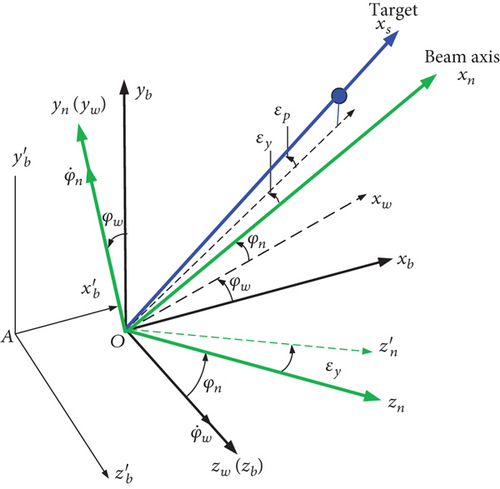
According to the coordinate systems above, from Oxbybzb to Oxwywzw, Ozb-axis is the axis of rotation; φw is the angle of rotation. From Oxwywzw to Oxnynzn, Oyw-axis is the axis of rotation; φn is the angle of rotation. From Oxnynzn to Oxsyszs, first, the axis of rotation is Oyn-axis and the angle of rotation is εy, and then, the axis of rotation is -axis (transition axis), and the axis of rotation is εp.
Figure 3 displays the coordinate transformation relationship.
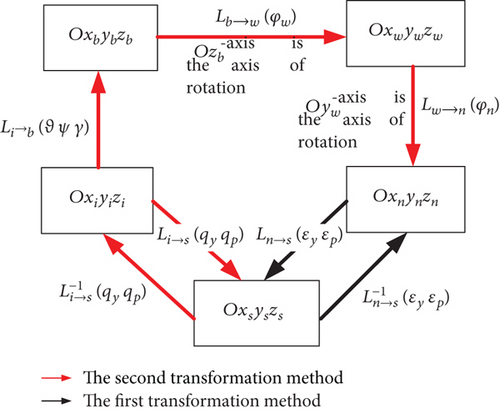
According to the coordinate systems above, from Oxiyizi to Oxbybzb, ψ, ϑ, and γ denote the missile body yaw, pitch, and roll angles; the axis of rotation is Oyi-axis, -axis (transition axis), and -axis (transition axis), respectively. From Oxiyizi to Oxsyszs, qy and qp are the LOS angles in the yaw and pitch directions; the axis of rotation is Oyi-axis, and -axis (transition axis), respectively. From Oxbybzb to Oxnynzn, φw and φn are the gimbal angles in the pitch and yaw directions; the axis of rotation is Ozb-axis and Oyw-axis, respectively. From Oxnynzn to Oxsyszs, εy and εp are the seeker antenna beam off-centered angles in the yaw and pitch directions; the axis of rotation is Oyn-axis and -axis (transition axis), respectively.
3.2. Model of the Antenna Beam Off-Centered Angle
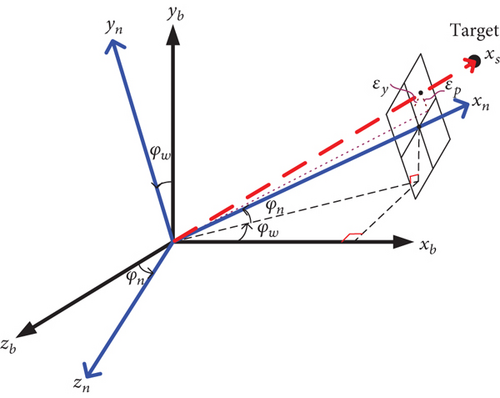
3.3. Dynamic Derivation of the Seeker Platform
Figure 5 demonstrates the LOS rate extraction model for the two-gimbal-coupled system. The model starts from the antenna beam off-centered angles computed by (6) and the corrective network using the lag compensation network to increase open loop gain with lag compensation coefficient β and time constant T; L is inductance and R is resistance in the motor model. First, through the antenna beam off-centered angle model, the εy and εp can be obtained, and then the off-centered angles can be amplified by the gain K1 or K3 to be LOS angle rate signal; the LOS angle rate error () can be amplified by the gain K2 or K4 to be voltage signal. The lag compensation network in the tracking loop (which is an angle position loop; its main function is to receive the off-centered angle signal, control the movement of the seeker platform, and realize the closed loop tracking to the target) can reduce the tracking error. The lag compensation network in the stability loop (which is an angle rate loop; its main function is to isolate the missile body motion and keep the beam stable in inertial space) can increase the open loop gain. The voltage signal through the motor model, moment coefficients KT1 or KT2, and load moment of inertia Jeq can output gimbal angular acceleration signal; gimbal angular rate can be obtained by integrating the gimbal angular acceleration signal. Finally, the gimbal angular rate feedback to the input point of the stability loops through the rate gyro model. The objective of the controller in Figure 5 is to align the antenna boresight with the LOS and eliminate the εy and εp promptly and in a stable way.
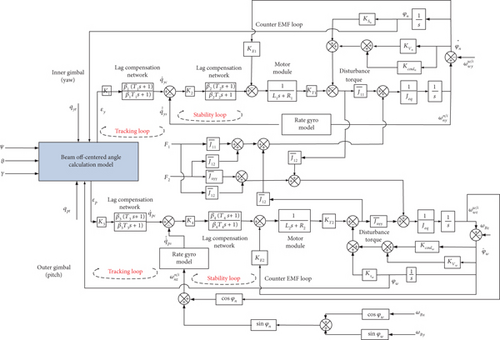
4. Dynamic Model Identification of the Seeker Control Loop
The analysis of the transfer function of the seeker platform and the inertial device is necessary before designing the seeker control system. The mathematical model of the transfer function is typically obtained through the system parameter identification method. The transfer function in frequency domain can be obtained by measuring the frequency characteristics of the inertial device to identify the system. In a sufficiently wide frequency range, the frequency of the input signal of the inertial device is continuously changed, the ratio of the output characteristic of the inertial device to the input characteristic is measured, and the decibel number for identifying the logarithmic amplitude-frequency characteristics is obtained.
In this study, in order to validate the method, we assume that the transfer function of the torque motor is a second-order model, which contains the motor model 1/(Ls + R), moment coefficient KT, back EMF coefficient KE, and moment of inertia Jeq. The torque motor model is shown in Figure 6.
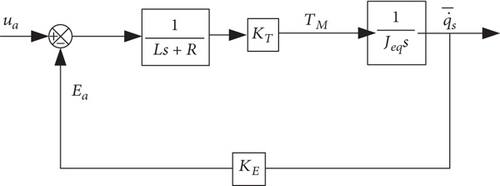
Setting , km = 1/KE, and , the stability loop can be shown in Figure 7.

Data fitting results are obtained for the experimental data at different input frequencies. Thus, we can measure the angle rate ratio . We can identify the value of the system parameters kn, tn, and ξn by using (31)–(33), and the values of the torque motor parameters km, tm, and ξm can be calculated by (30).
The input signal is the angular velocity signal obtained by differentiating the angular position signal, where the amplitude is 0.2°, and the frequency is 1.25–15.7 rad/s, with the inner gimbal as the measured object. The closed loop frequency characteristic of the seeker can be obtained by accessing the data processing. Figure 8 presents the frequency characteristic curve, where the dotted line is the measured data, and the solid line is the magnitude-frequency characteristics of the second order.
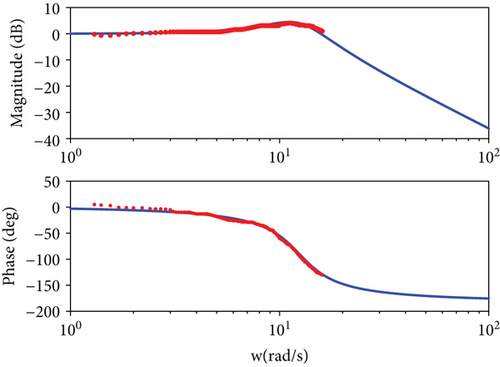
Then, we can obtain ωn = 12.42 rad/s (1.99 Hz), ξn = 0.315; the closed loop bandwidth is 17.9 rad/s (2.8 Hz).
Using the parameters Kf = 1.6, kg = 1, and Jeq = 0.0025995 in the stability loop, we can obtain the torque motor parameters km = 1.87, ωm = 6.2 rad/s, and ξm = 0.63 by using (30); they are matched with the true motor model; the frequency of the stability loop is nearly 2 times that of the motor model.
5. Simulation Analysis of the Seeker Two-Axis-Coupled Dynamic Model
Equations (19), (21), and (32) and Figure 5 reflect the complexity of the two-gimbal platform seeker system. The dynamic model includes not only the cross-coupling and mass imbalance but also the disturbance torque from the spring, viscous, and Coulomb friction torque factors. Moreover, the body attitude angle will couple into the seeker LOS rate output. We can simulate the tracking performances and coupling characteristics of the seeker according to the two-gimbal-coupled system block diagram illustrated in Figure 5. We assume that the inertia product and the mass imbalance moment are zero to verify the accuracy and availability of the seeker dynamic model. According to the test model of the seeker in laboratory, the dynamic parameters are summarized in Table 1.
| Parameter | Value |
|---|---|
| Operational amplifier | K1 = K3 = 12 |
| Power amplifier | K2 = K4 = 12 |
| Lag compensation network | T1 = T3 = 0.4 |
| T2 = T4 = 0.04 | |
| β1 = β2 = β3 = β4 = 15 | |
| Inductance | L2 = L4 = 0.0035H |
| Resistance | R1 = R2 = 8Ω |
| Torque coefficient | KT1 = KT2 = 0.2344 N × m/A |
| Back EMF coefficient | KE1 = KE1 = 0.5344 V/rad/s |
| Inner gimbal moment of inertia | Jnxx = 0.002 N × m × s2 |
| Jnyy = 0.02 N × m × s2 | |
| Jnzz = 0.004 N × m × s2 | |
| Outer gimbal moment of inertia | Jwxx = 0.004 N × m × s2 |
| Jwyy = 0.005 N × m × s2 | |
| Jwzz = 0.045 N × m × s2 | |
| Angular rate gyro | H(s) = 1/(0.000004s2 + 0.0028s + 1) |
Figure 9 shows the open loop Bode diagram of tracking loop with and without the lag compensation.
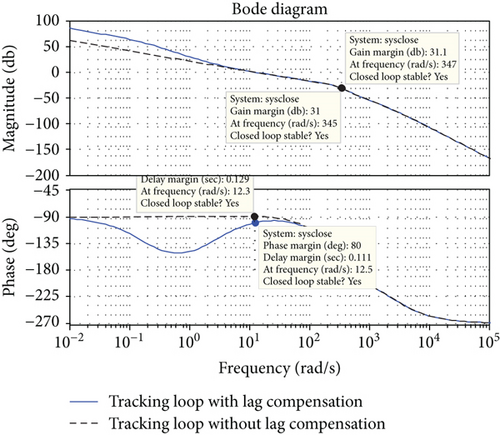
Figure 10 shows the open loop Bode diagram of stability loop with and without the lag compensation.
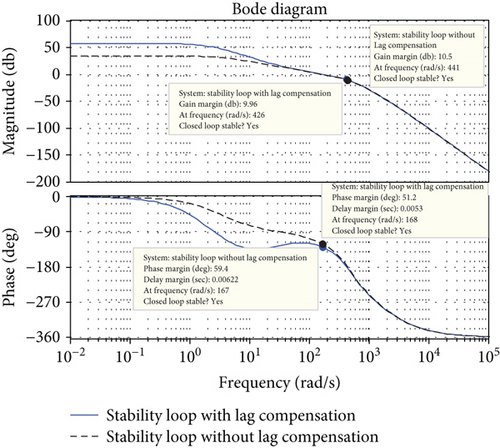
If the missile and the target are stationary and the relative distance is fixed, then the yaw angle is a constant value of the LOS angle input, and the missile body yaw angle is the positive rotation signal input. Figure 11 displays the simulation curve with body yaw direction input. The yaw gimbal will swing in the opposite direction when the missile body is yaw swinging to ensure the stability of the LOS because the LOS angle input has the constant value of 0. Therefore, the LOS angle output is near zero in the case of missile yaw disturbances, and the swing is not large. The lag compensation network can increase the open loop gain 15 times. The closed loop Bode diagram of tracking loop is shown in Figure 12, and the closed loop bandwidth is 12.37 rad/s (1.97 Hz), which is close to the frequency of oscillation (2 Hz). The open loop Bode diagram is shown in Figure 10; we can find that the lag compensation increases the open loop gain. The closed loop Bode diagram about stability loop is shown in Figure 13: the closed loop bandwidth is 370 rad/s (59 Hz), which is larger than the tracking loop and the frequency of oscillation and can improve the disturbance rejection capability.
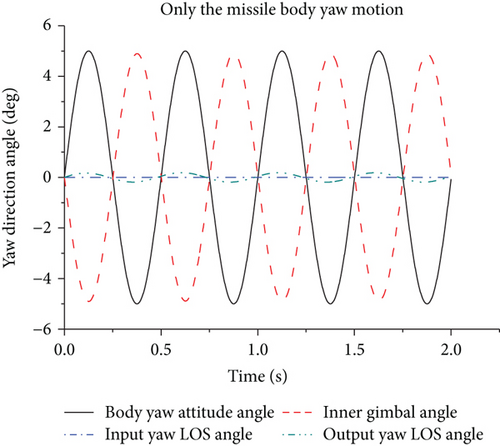
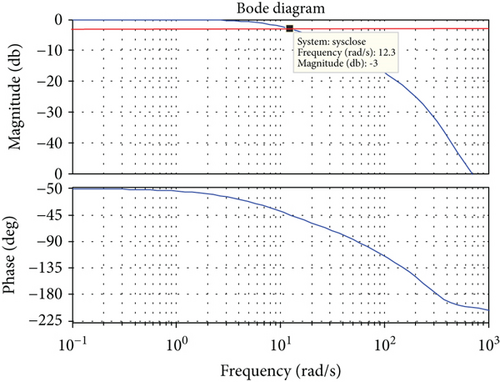
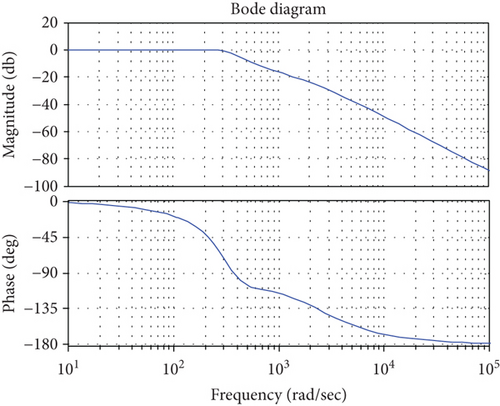
Figure 14 demonstrates the coupling swing curve of the pitch gimbal caused by the missile yaw movement. The missile yaw movement causes not only the yaw gimbal swing but also the pitch gimbal coupling swing.
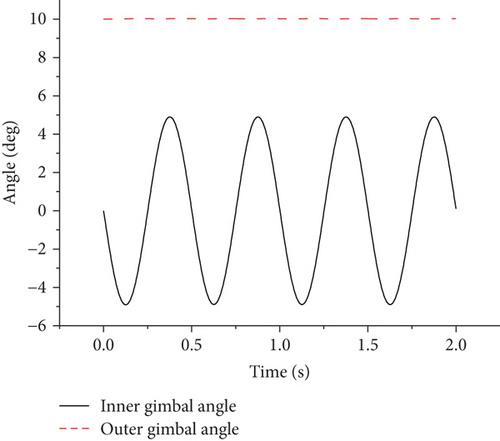

Figure 15 depicts the simulation curve with body pitch attitude angle input signal. The pitch gimbal will swing in the opposite direction when the body is swinging to ensure the stability of the LOS. The output pitch LOS angle is close to the input pitch LOS angle (which is zero). The closed loop bandwidth is greater than the frequency of oscillation. The frequency characteristic is the same as of the yaw gimbal.
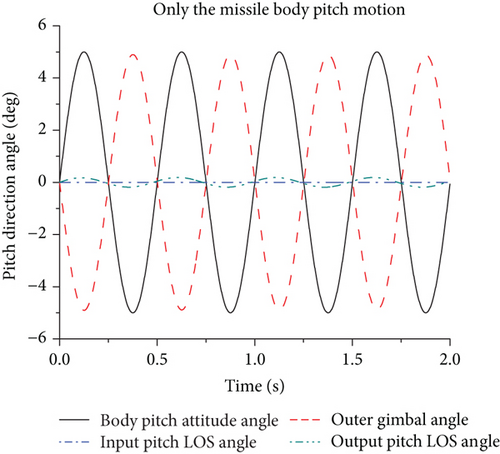
Figure 16 depicts the simulation curve with body pitch angle and yaw angle input. The pitch gimbal will swing in the opposite direction of the body pitch motion; the yaw gimbal will swing in the opposite direction of the body yaw motion, when the missile body pitch and yaw is swinging to ensure the stability of the LOS. Figure 17 presents the outer gimbal simulation curve with body pitch and yaw angle input or only the pitch angle input. We find that the outer gimbal angle swing amplitude is higher with body pitch and yaw input than only the pitch angle input given the coupling between the gimbal and the missile body and the coupling effect between the inner and outer gimbals.
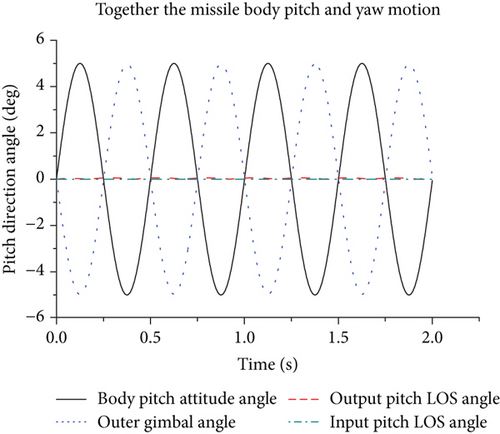
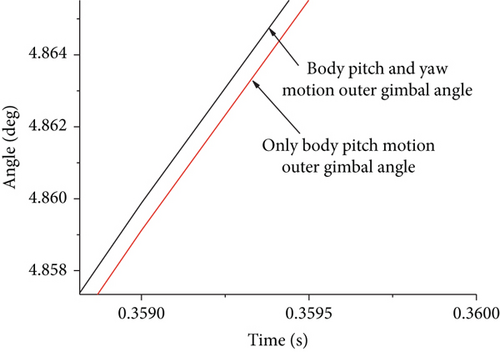

Figures 19 and 20 illustrate the disturbing rate rejection transfer function in frequency domain caused by viscous and spring torques, respectively. The disturbing rate rejection amplitudes are 1%, 3%, 5%, and 7% when the frequency is 2 Hz. In Figure 19, we find that the maximum value of the amplitude of the disturbing rate rejection transfer function is located near 2 Hz, where the operating frequency of the seeker is maximized and has a significant influence on the parasitic loop. In Figure 20, we find the serious rejection area under the action of spring torque which is located in the low-frequency band and presents the integral link characteristic. Spring and viscous torques will affect the tracking accuracy of the seeker.
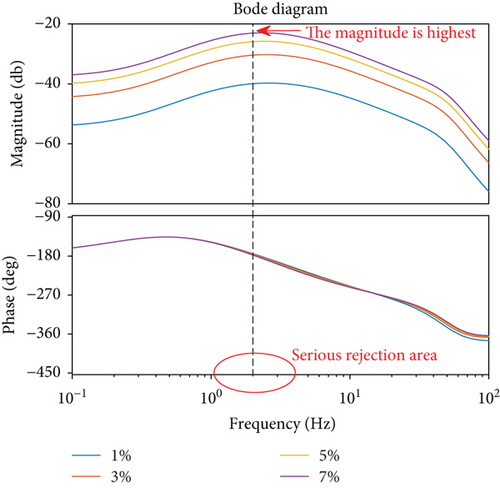
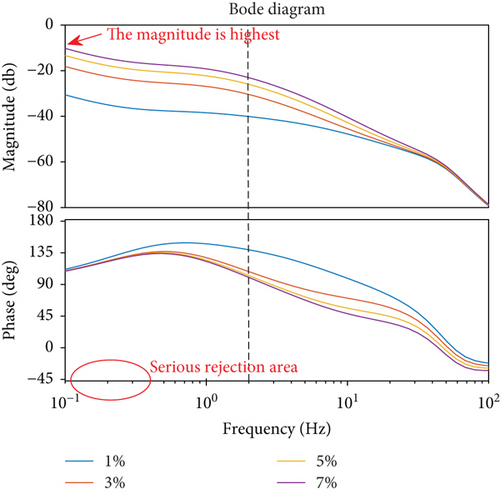
6. Conclusions
The two-axis rate gyro-stabilized platform dynamic model-based seeker with cross-coupling, mass unbalance, and disturbance torque is built according to the two-axis rate gyro stabilization platform tracking principle, applying the torque motor drive and seeker servo control theory and combining the platform framework kinematics theory and spatial coordinate transformation method. Simultaneously, two-gimbal-coupled system block diagram is built. The frequency domain method is used to identify the seeker sensor transfer function. This study comprehensively considers the conditions of the disturbance moment of the platform, coupling characteristics, and gimbal angle changing curve analyzed in different missile body inputs. Furthermore, the disturbing rate rejection caused by spring and viscous torque factors is analyzed. On the basis of the analysis, the coupling effect of the missile body to the gimbal is strong given the presence of disturbance torque. The missile motion is coupled to the seeker output, but the seeker servo stable platform can reduce the influence of the missile disturbance by swinging in the opposite direction. The coupling effect between the inner and outer gimbals is evident. The serious segregation area is located in the middle- and low-frequency band by analyzing the function frequency characteristics of disturbing rate rejection transfer caused by spring and viscous torque factors. Spring and viscous torque factors will affect the tracking accuracy of the seeker.
The results of this study can support the equivalence demonstration of the seeker servo control system in the closed loop simulation test and actual work conditions and thus uphold the study of the seeker servo control system and semiphysical simulation.
Conflicts of Interest
The authors declare that there is no conflict of interests regarding the publication of this article.
Acknowledgments
This work is supported in part by research grants from the Aviation Science Foundation, China (20150172001).




